

Non-Intrusive Kill-A-Gallon. Node-red/node-red-nodes. Node-RED : Installation. Install Node.js Node-RED requires version 0.10.x of Node.js.
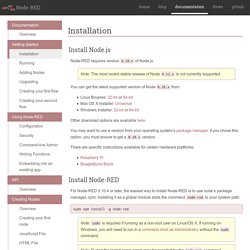
Note: The most recent stable release of Node 0.12.x is not currently supported. You can get the latest supported version of Node 0.10.x from: Arduino 1-wire temperature sensors. So you have played a bit with your Arduino, and have heard about other people using it to monitor the temperature, but weren’t sure how they did it – Here is how I did.
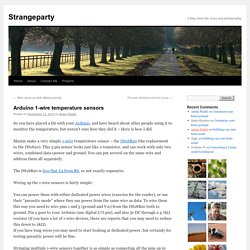
Maxim make a very simple 1-wire temperature sensor – the DS18B20 (the replacement to the DS1820). This 3 pin sensor looks just like a transistor, and can work with only two wires, combined data+power and ground. You can put several on the same wire and address them all separately. The DS18B20 is less that £4 from RS, so not exactly expensive. A Designers Guide to Lithium Battery Charging. Lithium-ion (Li-ion) batteries have become popular for portable electronics such as laptop computers and smart phones because they boast the highest energy density (capacity per unit volume) of any commercial battery technology.
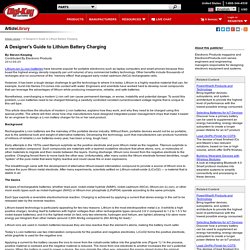
Other benefits include thousands of recharges and no occurrence of the “memory effect” that plagued early nickel cadmium (NiCd) rechargeable cells. However, it has been a tough design challenge to get the technology to where it is today. Lithium is a highly reactive material that can, for example, burst into flames if it comes into contact with water. Engineers and scientists have worked hard to develop novel compounds that can leverage the advantages of lithium while producing inexpensive, reliable, and safe batteries. Inductive Charging Set - 3.3V @ 500mA max ID: 1459 - $9.95. The squarish board with two chips on it is the transmitter (power with 9V).

The longer board is the output and you can connect that to the part of your project that needs powering. Batteries - Regulated 3.3V from a Lithium-ion (or LiPo) battery.
How to choose a battery: A battery chemistry tutorial. Gabe A. Cohn. PCB Design Tutorial CSE 599U: Fall 2010; CSE 477: Spring 2013, Spring 2011, Spring 2010 This tutorial covers schematic entry and PCB design.

Most of the material can be applied to any design tool; however, this tutorial focuses on Altium Designer/DXP/Protel. This tutorial consists of a set of slides which give an overview of PCB design and describe each step of the process. Field Monitoring Project. Earth Journalism Network. Internews Center for Innovation and Learning, Washington, DC Sensor Journalism Air Quality Science Journalism Particulate Matter Solutions Smoke Internet of Things You don’t need a sensor to know which way the smog is blowing.
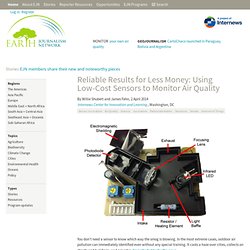
In the most extreme cases, outdoor air pollution can immediately identified even without any special training. It casts a haze over cities, collects on streets and buildings, and provides dramatic fodder for the news. But while high drama is often a prerequisite for news about air quality to be reported, the real story is the health impacts that occur even when the air isn’t thick enough to see. With this in mind, the Earth Journalism Network is working with scientists and hardware developers to create the DustDuino—a low-cost particulate matter monitor that can help media audiences understand the quality of the air they breathe.
There are some caveats, however. NILM bee. > > NILM bee The NILM bee is an extremely low-cost sensor node designed to assist Non-intrusive Appliance Load Monitoring applications.
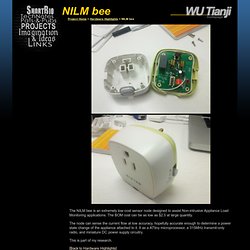
The BOM cost can be as low as $2.5 at large quantity. The node can sense the current flow at low accuracy, hopefully accurate enough to determine a power state change of the appliance attached to it. Arduino powered Haunted Mansion Singing Busts. Carr. Web-Enable your Arduino with an Arduino ENC28J60 Ethernet shield ... Arduino Ethernet - Pushing data to a (PHP) server. Arduino and ENC28J60 Ethernet Shield This article is based on using an Arduino ENC28J60 Ethernet shield, as discussed in our “How to web-enable your Arduino“, which we will use with one or more DS18B20 digital temperature sensors (you can consider using other sensors as well of course).
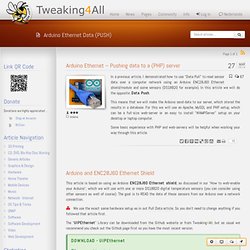
The goal is to READ the data of these sensors from our Arduino over a network connection. We use the exact same hardware setup as in out Pull Data article. So you don’t need to change anything if you followed that article first. The “UIPEthernet” Library can be downloaded from the Github website or from Tweaking4All, but as usual we recommend you check out the Github page first so you have the most recent version. DOWNLOAD - UIPEthernet Since we will be using the DS18B20 sensors, we will will also need the “OneWire” library, which can be found at OneWire Project Website (recommended) or can be download straight from Tweaking4All. WebClient. Arduino_uip/examples/UdpClient/UdpClient.ino at master · ntruchsess/arduino_uip.
Emoncms. Openenergymonitor/EmoncmsPythonLink. Emoncms. Web-enabled Arduino Temperature Logger. Raspberry Pi temperature logger. Raspberry Pi (boxed) temperature logger OK, so a while ago I built a little temperature measuring system using an Arduino Uno, an Arduino ethernet Shield, a real time clock module and some digital 1-wire temperature sensors.
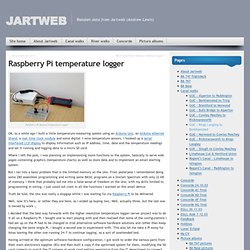
I hooked up a serial interfaced LCD display to display information such as IP address, time, date and the temperature readings and sat it running and logging data to a micro SD card. Where I left the post, I was planning on implementing more functions to the system, basically to serve web pages containing graphics (temperature charts) as well as store data and to implement an email alerting system. But I ran into a basic problem that is the limited memory on the Uno. Painless Streaming Plots with Bokeh. Painless Streaming Plots with Bokeh Bokeh is quickly proving to be the easiest plotting toolkit for web-enabled graphs.
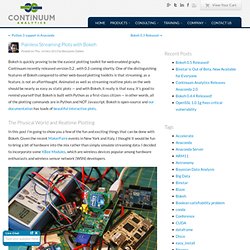
Continuum recently released version 0.2 , with 0.3 coming shortly. Operating an Arduino for a Year from Batteries. The Arduino is a great product for producing a custom data collection system or controller. Programming is easy via a high-level language and a simple USB connection to the Arduino board. Incredible popularity has brought plenty of publicly available code and many add-on boards for interfacing sensors, storage, and wireless communications. However, most of my projects involve collecting data for multiple months, and access to mains power is often problematic. Home Energy Monitor. Warning!
Parts of the circuits in this design are live. Mains electricity can be lethal. Unless you understand the risks, do not attempt to build or use this circuit. Arduino 1-wire temperature sensors. So you have played a bit with your Arduino, and have heard about other people using it to monitor the temperature, but weren’t sure how they did it – Here is how I did. Maxim make a very simple 1-wire temperature sensor – the DS18B20 (the replacement to the DS1820). This 3 pin sensor looks just like a transistor, and can work with only two wires, combined data+power and ground. You can put several on the same wire and address them all separately. The DS18B20 is less that £4 from RS, so not exactly expensive. Emoncms. First draft created: 27th September 2010 by Trystan Lea Note: new version of emoncms (v2) can be found here: This is a mini guide on how to create a web connected energy monitor and starts from where the guide for building the non-invasive mains AC v3 energy monitor leaves off.
JSON and automatic website setup One of the main features of this implementation is the use of JSON to send data from the arduino to the website. The website recieves this and if it doesn't already have a Voltage table, will create one and enter the value into the table. File:LM324N Operational Amplifier.png. LM324N Texas Instruments. PCB Manufacturers Reviews and Notes. High Accuracy Current Measurement Over a Wide Range. Educational Colorimeter Kit. RTD temperature sensing. Generating power with a stepper motor - Solar Heat Engines. 14" LCD LVDS bundle with capacitive touchscreen and ambient light sensor.
Merging Worlds. Raspberry Pi. Arduino.